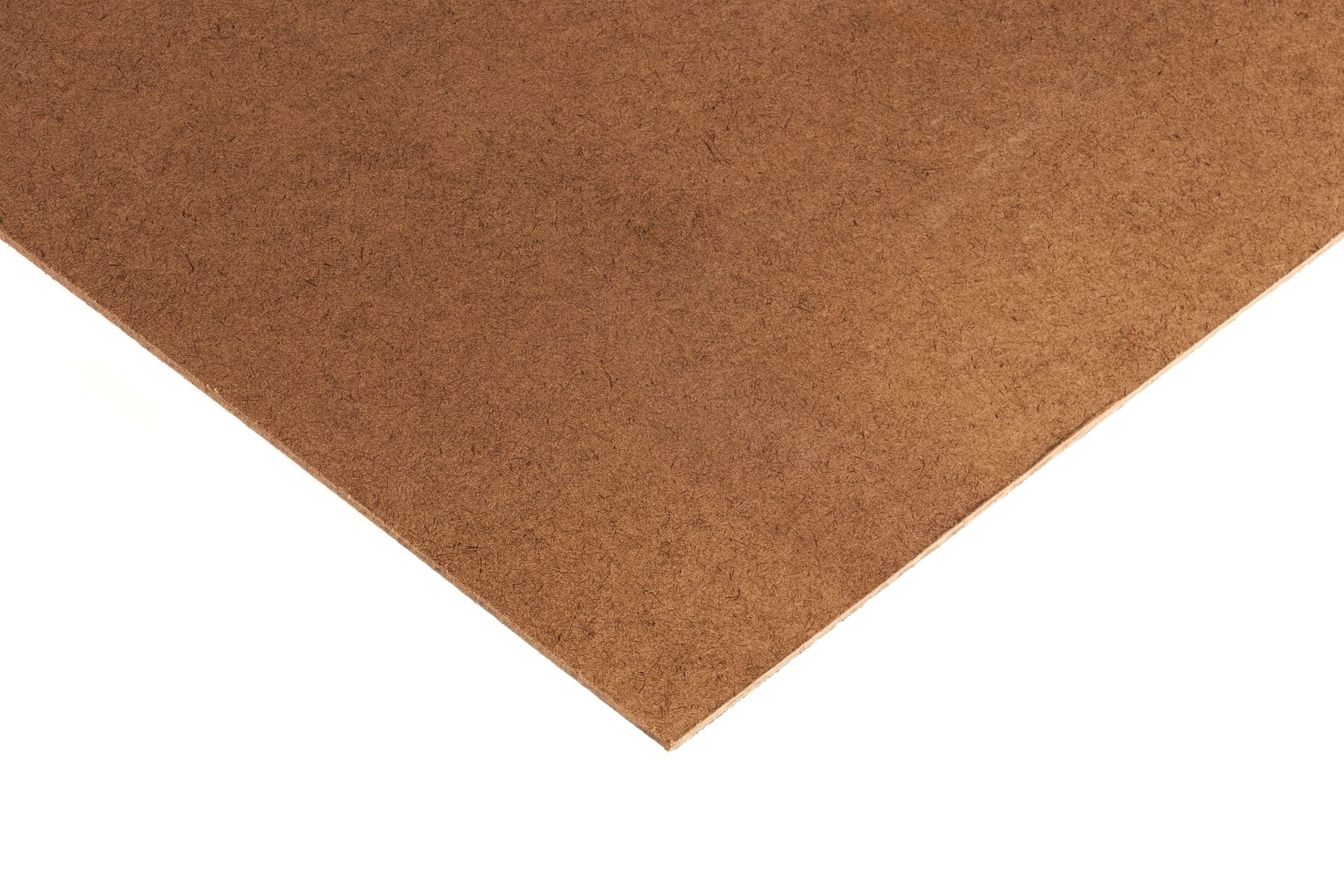Hardboard Sheets
(4 Products)Hardboard, also known as High-Density Fibreboard (HDF), is a widely utilised engineered wood product valued for its affordability, smooth surface, and versatility. From furniture construction and interior fittings to DIY projects and packaging, hardboard sheets offer a practical and consistent panel material.
What Are Hardboard Sheets?
Hardboard is an engineered wood panel, created by compressing fine wood fibres (often residuals from sawmill operations or specifically processed wood chips) under intense heat and pressure to form a dense, stiff, and consistently flat sheet.
This manufacturing method yields a panel with one very smooth, hard face (ideal for direct finishing) and a textured mesh pattern on the reverse, an imprint from the production process.
Its ease of working and excellent finishing properties make it a long-standing favourite for furniture backing, drawer bottoms, floor underlayment, shopfitting, and countless DIY and craft projects.
Applications
- Furniture & Cabinetry: Predominantly for back panels on bookcases, wardrobes, and kitchen units; also used for drawer bottoms and internal dividers, offering a smooth, stable, and economical lining.
- Floor Underlayment: Specific grades provide a thin, smooth, and level surface over existing timber subfloors (floorboards or chipboard), ideal as a base before laying resilient flooring like vinyl, LVT, linoleum, or carpet tiles, preventing subfloor imperfections from showing through.
- Interior Panelling & Linings: Utilised as wall or ceiling linings to create a smooth, paintable surface, especially in utility areas, garages, or for temporary partitioning and site hoardings.
- Door Skins: Forms the flat, smooth surface of many lightweight internal flush doors.
- Shopfitting & Retail Displays: Suitable for creating backing boards for shelving units, simple shelving components, and various elements of display units and point-of-sale stands due to its smooth finish and ease of customisation.
- Perforated Hardboard (Pegboard): A classic solution for organising tools in workshops and garages using hooks, and frequently employed for versatile retail merchandising displays.
- DIY, Crafts & Modelling: A popular choice for a wide range of projects requiring a thin, rigid, and easily workable sheet material, such as noticeboards, picture backing, and model bases.
- Packaging & Protection: Employed as durable separator boards between goods, protective coverings for vulnerable surfaces during transit or construction, or for crate linings.
Benefits
- Smooth Finishable Surface: The primary smooth side offers an excellent base for paint, varnish (tempered types), laminates, or veneers.
- Uniformity & Consistency: As an engineered product, it is free from knots, voids, or natural grain direction, ensuring consistent properties across the sheet.
- Workability: Can be easily cut, drilled, and shaped using standard woodworking tools.
- Paintability: Takes paint exceptionally well, especially after priming, allowing for a high-quality decorative finish.
- Thin Profile Availability: Its common availability in thin sheets (e.g., 3mm) makes it suitable for overlays, backings, and applications where minimal build-up in thickness is crucial.
- Density & Hardness: Provides a hard, relatively dense surface resistant to minor indentations and wear, particularly in tempered forms.
Tips for Cutting, Fixing, and Finishing
Cutting:
- Use fine-toothed saw blades (hand saw, circular saw, jigsaw) to minimise chipping on the smooth face.
- For power saws, orient the sheet so the blade enters the smooth face first (e.g., smooth face down for most circular saws that cut on the upstroke).
- Scoring the cut line deeply on the smooth side with a sharp utility knife before sawing can help achieve a cleaner edge.
- Thin sheets (e.g., 3mm) can sometimes be scored and snapped.
Fixing:
- Nails: Use fine panel pins or brads for thin hardboard. Avoid fixing too close to edges (maintain at least 10-12mm) to prevent splitting.
- Screws: Always pre-drill pilot holes, especially near edges, as hardboard can easily split. Countersink screw heads for a flush finish.
- Staples: Can be effective, particularly for fixing backing panels in furniture or for upholstery bases.
- Adhesives: Woodworking PVA glue (for dry interior applications), contact adhesive, or specific panel adhesives work well. Ensure surfaces are clean and dry.
- Expansion Gaps: For larger areas of panelling (e.g., wall linings), it's good practice to leave small expansion gaps (2-3mm) between sheets and around the perimeter to accommodate slight movement due to changes in humidity. These gaps can be covered with cover strips or mouldings.
Finishing:
- Priming: Standard hardboard should always be primed before painting, especially if using water-based paints, to seal the surface, ensure good adhesion, and achieve an even final coat. An acrylic or oil-based primer is suitable.
- Painting: Accepts most types of paint well once primed (emulsion, acrylic, oil-based). Applying multiple thin coats generally yields better results than a single thick coat.
- Varnishing: Tempered hardboard can be varnished to provide a durable, natural-looking, or slightly enhanced finish.
- Edge Treatment: Cut edges of hardboard are more porous and can absorb moisture readily. For applications where edges might be exposed to any dampness or for a neater finish, sealing them with paint, varnish, or a dedicated edge sealant is recommended.
Frequently Asked Hardboard Sheets Questions
Do I Need To Prime Hardboard Sheets Before Painting?
Yes, panels can be finished with paint to achieve the desired aesthetic. In most instances, we recommend that you apply three coats of gesso to hardboard prior to painting and lightly sand it between each coat.
What Is The Difference Between Standard Hardboard & Tempered Hardboard?
Standard hardboard is a brown panel with one smooth side and a coarse crosshatch reverse. Tempered hardboard has a second step in its manufacture; it is impregnated with linseed oil and then baked under high heat for enhanced moisture and impact resistance, rigidity and tensile strength.
Do Hardboard Sheets Swell When Wet?
Hardboard is just as vulnerable to moisture as other wood products. Rain or humidity may cause the boards to expand or warp, which might alter their appearance and reduce structural integrity.






